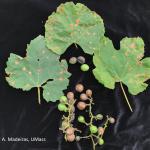Grape IPM- Black Rot
Black rot of grapes is caused by the fungus Guignardia bidwellii. It is one of the most common diseases of grapes in areas where the growing season is warm and humid.
Signs and Symptoms
All parts of the grapevine are susceptible. Young leaves are very vulnerable to infection, but they become resistant once they cease to expand. Round, tan lesions with dark purple to brown margins may be observed on leaves. Small, round, black fruiting bodies (pycnidia) are produced on the lesions and may be visible with a hand lens. Severe infection may cause leaf deformity. Black lesions may girdle petioles and shoots, resulting in wilt. Affected berries turn brown and soft at first, but within a few days they become hard, black, shriveled structures called mummies. Mummies are dotted with numerous pycnidia, which produce conidia, or asexual spores.
Life Cycle
G. bidwellii overwinters in infected mummies and other plant tissues on or near the vines. In spring, fruiting bodies called pseudothecia produce ascospores via sexual reproduction. These spores are blown by wind onto the surfaces of developing plant tissues. Warm, wet or humid weather is conducive to spore germination and infection. New lesions eventually form, and pycnidia produce a new round of spores which are spread by splashing rain. The disease cycle may continue as long as environmental conditions are conducive.
Optimum conditions for infection are 70-80°F with 6-7 hours leaf wetness duration. Infection can occur at temperatures from 50°F to 90°F, but outside of the 70-80°F range a longer leaf wetness duration is required.
Fruit infection occurs within approximately 4-6 weeks after bloom. The length of time between infection and symptom development depends upon temperature and the stage of host tissue maturation: several weeks may elapse before disease is apparent. Fruit becomes resistant to infection once veraison has begun.
Management
Cultural/Biological:
Sanitation is the most important element of a successful black rot management program. Remove infected canes, spurs, and fruit clusters remaining on the vines. Rake up and dispose of fallen leaves and mummies. Alternatively, mulch may be used to bury mummies and prevent spores released in spring from reaching new grape tissues. Cultivation beneath the vines prior to bud break can also bury mummies and reduce initial inoculum.
Reduce humidity in the plant canopy by removing canes or leaves. Manage weeds, which will also help reduce humidity. All cultivars of Vitis vinifera are highly susceptible to black rot, while some hybrids and other Vitis species are less susceptible. No species or cultivar is completely resistant.
Chemical:
Applications of protectant fungicides such as sulfur (Bordeaux mix), copper, or mancozeb should begin shortly before bloom and be repeated at the intervals recommended on the label until approximately 4-6 weeks post bloom. Thorough coverage is important. Later infections may also be managed by systemic fungicides. A full list of fungicides labeled for black rot of grapes can be found in the New England Small Fruit Management Guide: https://ag.umass.edu/fruit .
Disease forecasting models are used to predict periods of high disease pressure, enabling growers to plan sprays for times when they should be most effective. A forecasting model for grape black rot can be found at http://newa.cornell.edu/.

